- News
- Reviews
- Bikes
- Components
- Bar tape & grips
- Bottom brackets
- Brake & gear cables
- Brake & STI levers
- Brake pads & spares
- Brakes
- Cassettes & freewheels
- Chains
- Chainsets & chainrings
- Derailleurs - front
- Derailleurs - rear
- Forks
- Gear levers & shifters
- Groupsets
- Handlebars & extensions
- Headsets
- Hubs
- Inner tubes
- Pedals
- Quick releases & skewers
- Saddles
- Seatposts
- Stems
- Wheels
- Tyres
- Tubeless valves
- Accessories
- Accessories - misc
- Computer mounts
- Bags
- Bar ends
- Bike bags & cases
- Bottle cages
- Bottles
- Cameras
- Car racks
- Child seats
- Computers
- Glasses
- GPS units
- Helmets
- Lights - front
- Lights - rear
- Lights - sets
- Locks
- Mirrors
- Mudguards
- Racks
- Pumps & CO2 inflators
- Puncture kits
- Reflectives
- Smart watches
- Stands and racks
- Trailers
- Clothing
- Health, fitness and nutrition
- Tools and workshop
- Miscellaneous
- Buyers Guides
- Features
- Forum
- Recommends
- Podcast
review
£1,000.00
VERDICT:
A decent frame and finishing kit but heavy wheels. Next year's model is better value for money
Weight:
10,000g
Contact:
www.paligap.cc/Marin-Argenta-Elite_6643_p
At road.cc every product is thoroughly tested for as long as it takes to get a proper insight into how well it works. Our reviewers are experienced cyclists that we trust to be objective. While we strive to ensure that opinions expressed are backed up by facts, reviews are by their nature an informed opinion, not a definitive verdict. We don't intentionally try to break anything (except locks) but we do try to look for weak points in any design. The overall score is not just an average of the other scores: it reflects both a product's function and value – with value determined by how a product compares with items of similar spec, quality, and price.
What the road.cc scores meanGood scores are more common than bad, because fortunately good products are more common than bad.
- Exceptional
- Excellent
- Very Good
- Good
- Quite good
- Average
- Not so good
- Poor
- Bad
- Appalling
Marin's Argenta Elite is an easy bike to live with. The metre-long wheelbase and upright riding position make for a stable ride. This, coupled with a solid aluminium alloy frame, gets you a bike that offers no surprises whatever the conditions, making it perfect for the novice rider or those who like a more relaxed time in the saddle - especially at its current discounted price.
Find your nearest dealer here
Buy this online here
Easygoing
A lot of the bikes coming in for testing lately are what's known as Endurance bikes. The head tube is taller than traditional race geometry, with the top tube knocked back a bit in length. This creates a slightly more upright seating position, even when you're in the drops.
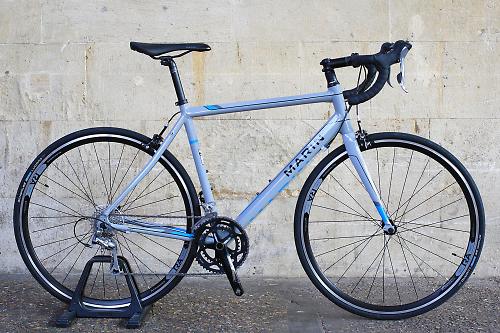
The Argenta's frame feels one of the most compact I've ridden, considering the effective top tube length of 55cm on this 52.5cm frame size. Surprisingly the Marin has a very steep seat tube angle of 74 degrees, something you'd be more likely to see on a full-on race steed where you are positioned forward over the bottom bracket, though the 72-degree head angle is more the norm.
The long wheelbase, coupled with the slack head, makes for some very neutral steering. Because of this the Argenta lacks any real feedback, and can feel very vague at times – not helped by the hard compound rubber of the Schwalbe Lugano tyres. They offer little grip, which can be unnerving through twisty sections when things get technical or if it's damp.
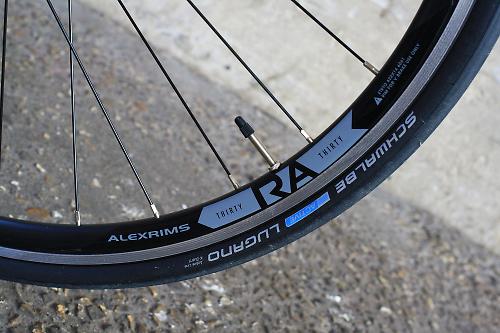
The Marin likes to cruise, though; you can sit aboard it for hours without suffering any fatigue or pain – well, apart from in your legs dragging the 10kg weight around. It'd make a perfect entry-level audax machine where all you want underneath you is a bike that'll tap out the miles with little in the way of surprises.
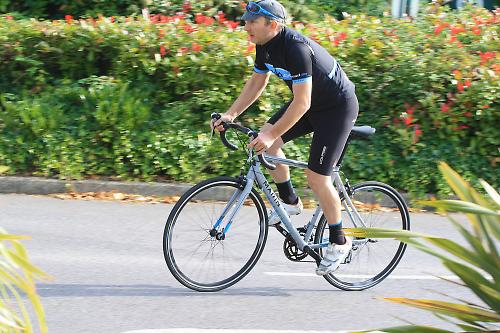
If you like to ride in the hills, Marin has selected a 10-speed SRAM cassette with a range of 11-28 teeth in the cassette. You do get some clunky jumps of three teeth at the larger end of the cassette but it's a small price to pay for some low climbing gears when matched to the 50/34 compact chainset up front. Again, that seat angle comes into play as I like to position myself further back in the saddle for seated climbing and the Argenta is just too heavy to go honking out of the seat on steep climbs.
Frame & fork
For the money you get a 6061 aluminium alloy frame, with each of the tubes being double butted – a thinner wall thickness at the centre of the tubes than at the ends for compliance and a little bit of weight saving.
Aluminium gets a bad rap for being harsh and overly stiff, but once again the Marin's ride-feel dispels that myth. The Argenta has curved seatstays, a common idea that having a large radius promotes flex, taking out road vibration before it reaches the rider.
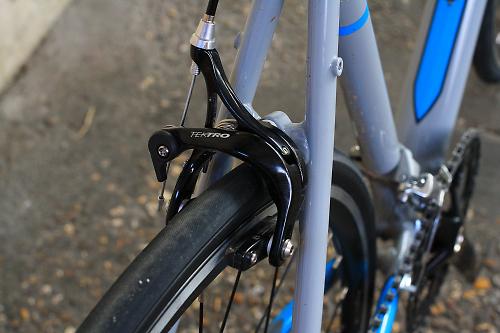
The rest of the tubes are nothing outlandish. You don't get an oversized down tube or deep chainstays for maximum stiffness, but I think the Marin is all the better for it – it doesn't need it for the style of riding the Argenta is intended for.
It's a nice frame on the whole. It feels very solid and looks to be well built, all finished in a deep paintjob, one of the thickest I've seen on a bike at this price point and really hardwearing.
You won't find a tapered head tube, with Marin staying with a traditional 1 1/8in headset top and bottom. If you're used to riding plenty of bikes with oversized headsets, you can notice the minimal amount of flex there under braking and fast bends, but it is just that, minimal.

The main selling point of the Marin, though, is that it takes full mudguards and a rack, making it a perfect contender as a commuter or winter trainer. There's still plenty of clearance around the 25mm tyres it comes with as standard, so fitting some 28s shouldn't be an issue at all, but I'd stick with the 25s with mudguards.
The fork is carbon fibre – well, carbon legs and alloy steerer. There seems to be plenty of stiffness under load and it certainly offers a comfortable ride. As you'd expect, it has full mudguard mounts to complement the frame.
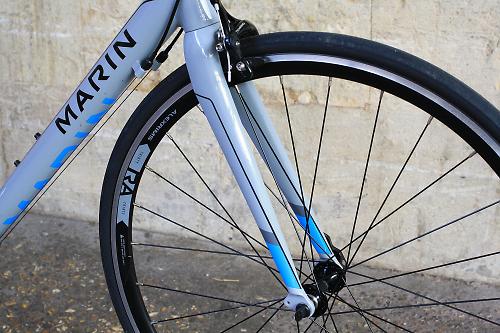
As far as the bottom bracket goes, Marin has stayed traditional here too, using a threaded shell to screw the MegaExo bearing cups into. It's a much better option than PressFit bearings on a bike to be used in all weather conditions, as these have a reputation for creaking due to water ingress, especially if the installer has scrimped on grease. Threaded bearing cups are much easier for the home mechanic to remove and reinstall too, ideal on the winter maintenance front.
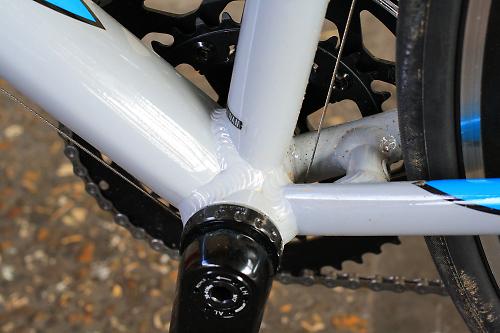
Finishing kit
The specification list on the Marin is more like a parts catalogue; probably in a bid to keep costs down, the company has specced components from many suppliers.
The majority of the groupset is from Shimano's Tiagra range. You get the 10-speed shifters, front mech and a long cage rear mech to cope with the aforementioned wide-range SRAM cassette.

The shifting is solid and okay; it lacks the defining click of 105 and above, but it's a smooth gear change and works well even under load.
FSA provides the chainset. It's FSA's Gossamer crank which sits in the lower part of the range, but it runs true and has durable rings which makes it ideal for winter use. Again you get a decent crisp shift between the two rings.

The brakes are Tektro R340s, with deep drops to provide clearance for the mudguards. Braking performance is adequate without being anything too special, as there is some flex in the callipers, and the hard compound pads just feel vague through the levers. You never quite know when you are going to stop.
Under hard braking you do get an instant bite from the pads, though this seems to fade quickly and any confidence you have in stopping quickly is soon lost as the brakes just end up feeling as lifeless as before.
They do come with cartridge pads, though, so changing to a better grade for a little bit of extra grab is a simple and cost effective upgrade.
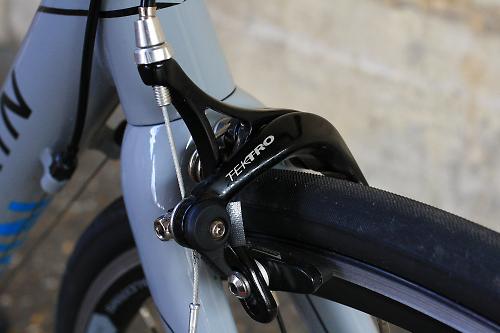
The rest of the finishing kit is Marin branded stuff and it's as expected: all aluminium components offering a solid base to rest your contact points. The bar has a shallow drop like most these days, which definitely suits the tall frontal position of the bike. You can use the drops without having to contort yourself into some sort of aero tuck.
The saddle is a particular highlight: very plush with quite a bit of padding but firm enough to be supportive and comfortable for long rides without any bouncing or pressure points.

Wheels & tyres
Alex rims and Formula hubs are seen on quite a lot of bikes at this price so it's no surprise to find them here on the Marin. The rims are called Thirty, basically because they are 30mm deep, but any minimal aero advantage is soon wiped out by the weight. The wheels, tyres, tubes, rim tape and skewers come in at a huge 3.2kg, that is some weight to get spinning, and it's certainly noticeable from a standing start.
Both front and rear have 28 spokes, which is enough to cope with most things, though I'd prefer to see a shallower rim with 32 spokes crossed to cope with proper load carrying. The Argenta might not be a touring mount, but with the ability to hold a rack and mudguards and that upright geometry it could easily handle a cross country jaunt or something similar.

The Schwalbe Lugano tyres, as I already mentioned, aren't very grippy at all thanks to such a hard compound. Taking a corner or roundabout fast has them squeaking as they struggle to adhere to the tarmac, and when the grip goes it goes in an instant. There is no gentle slide that you can come back from.
>> Check out our guide to the best road cycling tyres here
They are robust, though, and certainly shrug off any cuts from road debris. It's hedge cutting season and that with some rain means there have been a few anxious miles around the country lanes, but thankfully the puncture fairy didn't visit once.
Value
The model we've got here is from the 2015 range and costs £1000, which I think is too expensive for what it is. A lot of bikes with an alloy frame, carbon fork and Tiagra groupset come in around the £900 mark, and this is where I'd expect the Argenta Elite to sit.
>> Check out our guide to the best road bikes under £1,000 here
Marin must agree, as the 2016 model gets a new black paintjob, an upgrade to a carbon seatpost and new rims, yet a price drop to £850, making it a much more interesting proposition.
If you like the battleship grey finish of this 2015 model, I've found it online discounted to £500. Now that is a bargain.
Overall
This review may seem a little harsh on the Argenta Elite overall, so I'll break it down a bit. The underlying fact is that reviewed at the £1000 price the equipment is too low a spec. What is important, though, is that you are getting a really good frame. It's well made and offers a very smooth, comfortable ride.
The addition of mudguard and rack mounts makes it versatile as it could be used as a commuter or winter hack, and with the new 2016 price it comes in well under the cycle to work scheme limit.
The wheels and tyres kill it, though, in terms of performance and grip. The weight makes the Marin hard work to ride on anything but a flat, uninterrupted route.
So, either get a bargain 2015 model or the cheaper 2016 model once they hit the shops, but upgrade the wheels and tyres for a lighter, more engaging ride.
Verdict
A decent frame and finishing kit but heavy wheels. Next year's model is better value for money
road.cc test report
Make and model: Marin Argenta Elite
Size tested: 52.5cm
About the bike
State the frame and fork material and method of construction. List the components used to build up the bike.
Bottom Bracket: FSA MegaExo
Brake Levers: Shimano with Integrated Shifters
Brakes: Tektro R340 Dual Pivot with Cartridge Pad
Cassette: SRAM PG1030, 11-28, 10-Speed
Chain: Shimano CN4601
Crankset: FSA Gossamer, 50/34T
Fork: Endurance Road Carbon Blade w/1 1/8" Alloy Steerer
Frame: 6061 Aluminium, Double Butted with Endurance Fit Geometry
Front Derailleur: Shimano Tiagra
Front Hub: Formula, 28 Hole Road
Grips: Marin Road Plus Tape
Handlebar: Marin Butted Alloy OS 31.8mm Compact
Headset: FSA Orbit C, 1 1/8" with Cartridge Bearings
Pedals: Composite with Alloy Cage
Rear Derailleur: Shimano Tiagra
Rear Hub: Formula, 32 Hole Road with Cassette Freehub Body
Rims: Alex RA30, Aero Profile, Double Wall
Saddle: Marin Speed Concept with Cromoly Rails
Seatpost: Marin Comp Alloy Micro Adjust, 15mm Offset, 350mm
Shifters: Shimano Tiagra STI, 2x10-Speed
Spokes: 14 Gauge Black Stainless
Stem: Marin Forged OS Alloy Threadless, 31.8mm Bar Clamp
Tyres: Schwalbe Lugano Folding Bead with Kevlar Puncture Guard 700 x 25c
Tell us what the bike is for, and who it's aimed at. What do the manufacturers say about it? How does that compare to your own feelings about the bike?
Marin says, "The Argenta line of road bikes are built for enthusiasts and competitors alike. Design features include Endurance Fit geometry - with a longer wheelbase, shorter cockpit, and relaxed head-tube angle - allowing greater comfort and stability."
The Argenta fits perfectly into the Endurance catagory with its short feeling compact and very upright riding position.
Frame and fork
Overall rating for frame and fork
7/10
Tell us about the build quality and finish of the frame and fork?
The Marin has a solid feeling frameset that doesn't vibrate or resonate at all. It's no lightweight but is comfortable and stable to ride. The paintjob has some depth to it too.
Tell us about the materials used in the frame and fork?
The frame is manufactured from double butted 6061 aluminium alloy which is paired with a fork that has carbon fibre legs and an alloy steerer, which is straight at 1 1/8in top to bottom.
Tell us about the geometry of the frame and fork?
It follows the style we're seeing on a lot of endurance and sportive bikes of late. This 52.5cm frame has a 55cm effective top tube with a tall 17cm head tube. The Marin does have a surprisingly steep 74-degree seat tube more akin to a race bike.
Full details are here - http://www.marinbikes.com/gb/bikes/description/2016-argenta-elite
How was the bike in terms of height and reach? How did it compare to other bikes of the same stated size?
It feels very short in the top tube considering the 55cm effective length.
Riding the bike
Was the bike comfortable to ride? Tell us how you felt about the ride quality.
Yes it was. Yet another alloy bike that dispels the overly stiff and uncomfortable ride.
Did the bike feel stiff in the right places? Did any part of the bike feel too stiff or too flexible?
For the type of riding the Marin is intended for the level of stiffness is never put into question. You'd have to be sprinting pretty hard to get any feeling of movement around the bottom bracket.
How did the bike transfer power? Did it feel efficient?
Plenty good enough; it delivers a smooth ride when picking up speed, although the overall weight is a bit of a compromise if you really need to get a lick on.
Was there any toe-clip overlap with the front wheel? If so, was it a problem?
Yes, not an issue as long as you remember.
How would you describe the steering? Was it lively, neutral or unresponsive? Pleasantly neutral.
Tell us some more about the handling. How did the bike feel overall? Did it do particular things well or badly?
The Argenta handles exactly as it should, no surprises and very stable too thanks to the longish wheelbase.
Which components had the most effect (good or bad) on the bike's comfort? would you recommend any changes?
The Marin saddle was very plush without being soggy, perfect for long miles, but the bar tape could do with swapping for something thicker.
Which components had the most effect (good or bad) on the bike's stiffness? would you recommend any changes?
The alloy steering components overall a good feeling of stiffness when you are out of the saddle.
Which components had the most effect (good or bad) on the bike's efficiency? would you recommend any changes?
The SRAM wide range cassette gives a great spread of gears for descending and climbing, even though the jumps can be a little large at the top of the block.
Rate the bike for efficiency of power transfer:
7/10
Rate the bike for acceleration:
7/10
Rate the bike for sprinting:
6/10
Rate the bike for high speed stability:
7/10
Rate the bike for cruising speed stability:
8/10
Rate the bike for low speed stability:
8/10
Rate the bike for flat cornering:
8/10
Rate the bike for cornering on descents:
7/10
Rate the bike for climbing:
7/10
The drivetrain
Rate the drivetrain for performance:
7/10
Rate the drivetrain for durability:
8/10
Rate the drivetrain for weight:
7/10
Rate the drivetrain for value:
9/10
Tell us some more about the drivetrain. Anything you particularly did or didn't like? Any components which didn't work well together?
The 4600 edition of Tiagra is a solid performer and very cost effective. The shifting may not be super slick or look the best with its external cabling, but it's hard to fault for the money.
Wheels and tyres
Rate the wheels and tyres for performance:
6/10
Rate the wheels and tyres for durability:
7/10
Rate the wheels and tyres for weight:
6/10
Rate the wheels and tyres for comfort:
8/10
Rate the wheels and tyres for value:
7/10
Tell us some more about the wheels and tyres.Did they work well in the conditions you encountered? Would you change the wheels or tyres? If so, what for?
The Alex wheels are okay in terms of durability and they roll pretty smoothly. Other bikes with similar rims have shown no issues of late, although earlier versions did suffer from spoke breakage. The tyres felt okay in terms of rolling resistance but lacked any real grip thanks to their hard compound. Fast bends and roundabouts can be a bit of a bum clencher even in the dry.
Controls
Rate the controls for performance:
7/10
Rate the controls for durability:
8/10
Rate the controls for weight:
7/10
Rate the controls for comfort:
7/10
Rate the controls for value:
7/10
Tell us some more about the controls. Any particularly good or bad components? How would the controls work for larger or smaller riders?
The Marin branded components are simple but effective. The shallow drop bar offers plenty of hand positions for the majority of riders.
Your summary
Did you enjoy riding the bike? It was okay, though the reach felt a little short for me.
Would you consider buying the bike? No
Would you recommend the bike to a friend? Yes
Rate the bike overall for performance:
7/10
Rate the bike overall for value:
6/10
Use this box to explain your score
At the 2016 price of £850 the Marin is much better value for money than the 2015 rrp of £1000, hence the low value score for the tested model. On the whole the Argenta is a solid bike with a decent frame and fork. It may not be that exciting to ride but that stability can be a benefit to tired or novice riders. Sensible finishing kit and the ability to fit rack and mudguards mean the Marin makes a versatile and competent year-round commuter, especially at the reduced prices. If you fancy the 2015 model pictured here then take a look around the internet – I found it for just £500!
About the tester
Age: 37 Height: 180cm Weight: 76kg
I usually ride: Kinesis T2 My best bike is: Mason Definition
I've been riding for: 10-20 years I ride: Every day I would class myself as: Expert
I regularly do the following types of riding: time trialling, commuting, club rides, sportives, fixed/singlespeed
Since writing his first bike review for road.cc back in early 2009 senior product reviewer Stu has tested more than a thousand pieces of kit, and hundreds of bikes.
With an HND in mechanical engineering and previous roles as a CNC programmer/machinist, draughtsman and development engineer (working in new product design) Stu understands what it takes to bring a product to market. A mix of that knowledge combined with his love of road and gravel cycling puts him in the ideal position to put the latest kit through its paces.
He first made the switch to road cycling in 1999, primarily for fitness, but it didn’t take long for his competitive side to take over which led to around ten years as a time triallist and some pretty decent results. These days though riding is more about escapism, keeping the weight off and just enjoying the fact that he gets to ride the latest technology as part of his day job.
Latest Comments
- imajez 5 hours 19 sec ago
- looks like someone has fallen for the steel is real markerting BS. I only care how a bike rides, not what it is made of. I had a lovely steel...
- lonpfrb 6 hours 20 min ago
That argument is ignorance of the widespread height and width restrictions to be found on the many minor roads that were originally created for...
- David9694 8 hours 36 min ago
cyclists should be made to have number plates - Interesting police video here of the range of illegal number plates - we'd got, as the caption says...
- rookybiker 9 hours 49 min ago
The trailer seems to connect to both ends of the rear axle. Can it do tight corners without dragging the tyre sideways?
- froze 9 hours 52 min ago
Motorists have always been unkind to cyclists, but distracted driving is adding to the problem....
- Destroyer666 10 hours 45 min ago
Have you owned Bont shoes? In my experience even the widest Lake shoes have had a bizarre form of narrowing way too much in the toe area. But the...
- froze 11 hours 13 min ago
Not sure if this is possible, but this news letter goes out all over the world, and some places like Decathlon does not send stuff to America, in...
- Hirsute 11 hours 58 min ago
I'm confused as to why you'd need bib shorts indoors.
- Oldfatgit 12 hours 26 min ago
I'm sure you were being sarcastic... however ... Lewis Hamilton lives in Monaco. Yet another car driver that doesn't pay any tax






























Add new comment
5 comments
One good thing about a Marin road bike is they're rare. Everyone seems to ride trek, giant, cannon dale, boardman etc.
I have a 2014 Argenta Comp, got it at the end of 2013. Glad to know there's at least one other Marin road bike rider on here, I was feeling a bit lonely. Have to confess that I'm a bit of a Marin obsessive. I've had 6 bikes since the early 90's and 5 of them were Marin's, currently have my Argenta and a '96 Nail Trail which is my commuting bike.
I changed out the Schwalbes on mine for Vittoria Corsa CXs as even at my stately pace cornering was a bit sketchy. Never had any punctures but no real confidence either. I suppose I'll replace the wheels sometime but at the moment my uphill speed is a function of my ability not the wheels weight.
The saddle is one of the most comfortable stock units I've ever had.
Marin are struggling hard to re-establish themselves in the UK, having been one of the major MTB brands in the 80's and 90's and the expansion of their range into road bikes has taken a long time to get a hold. Hopefully their Gestalt and Four Corners bikes will help improve their profile.
I have a 2014 Marin argenta and I can safely say it's not good at going up hills. I have a tt bike as well (basic ribble ) and this flies up in comparison. And the tyres on the Marin were awful on the wet British roads with multiple punctures. If you do buy this bike it is bombproof but I agree that you do need to change the wheels and tyres ( gator skins for me as I'd rather not change inner tubes every weekend).
I am sure it will come up soon on the deal catcher for £650 as the deal of the century!
Yes, £1000 seems steep for this, given what is available half the price or better.